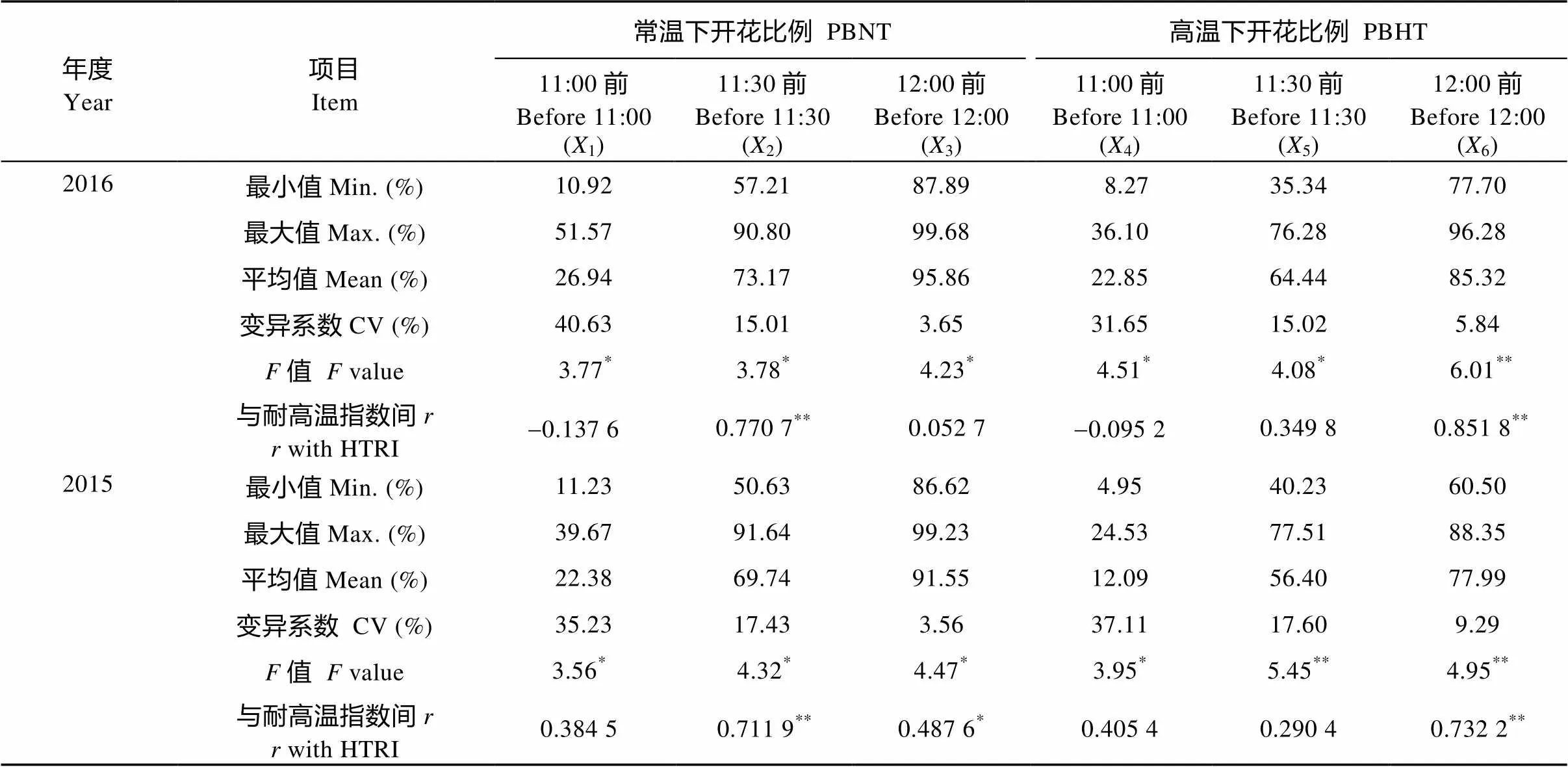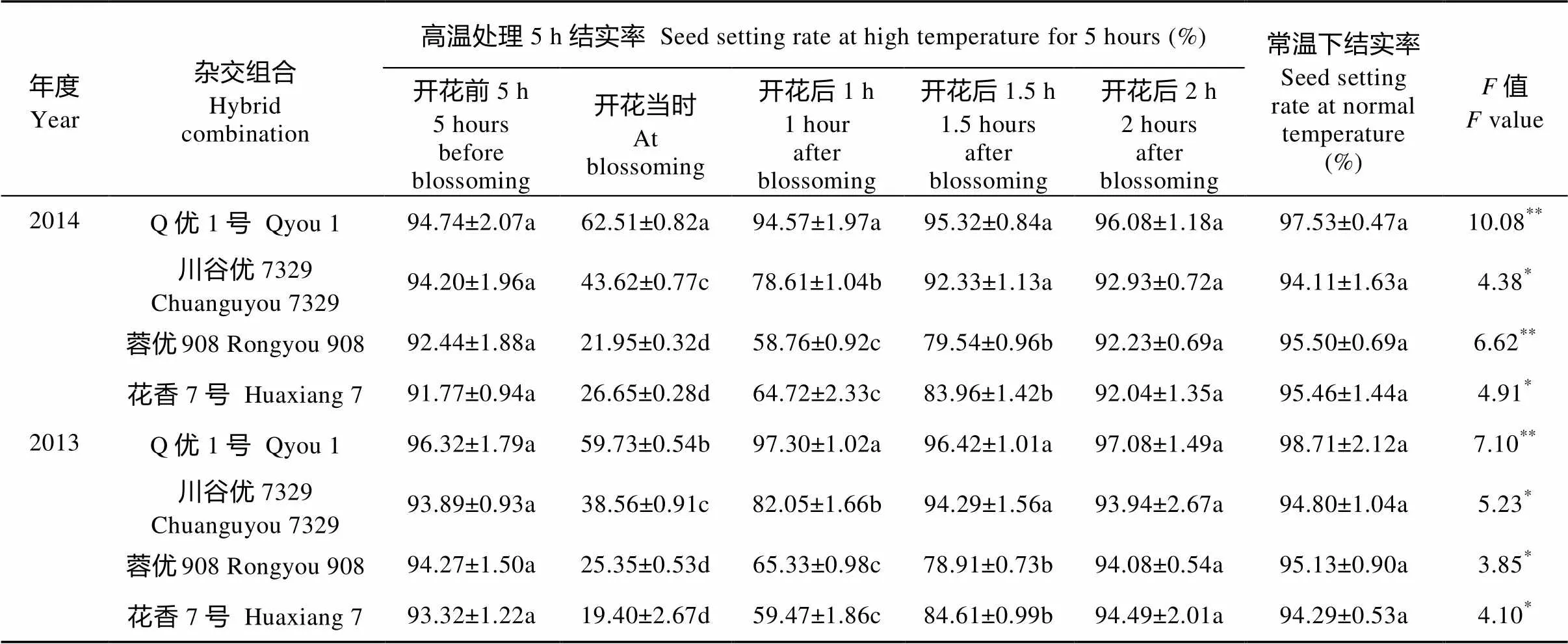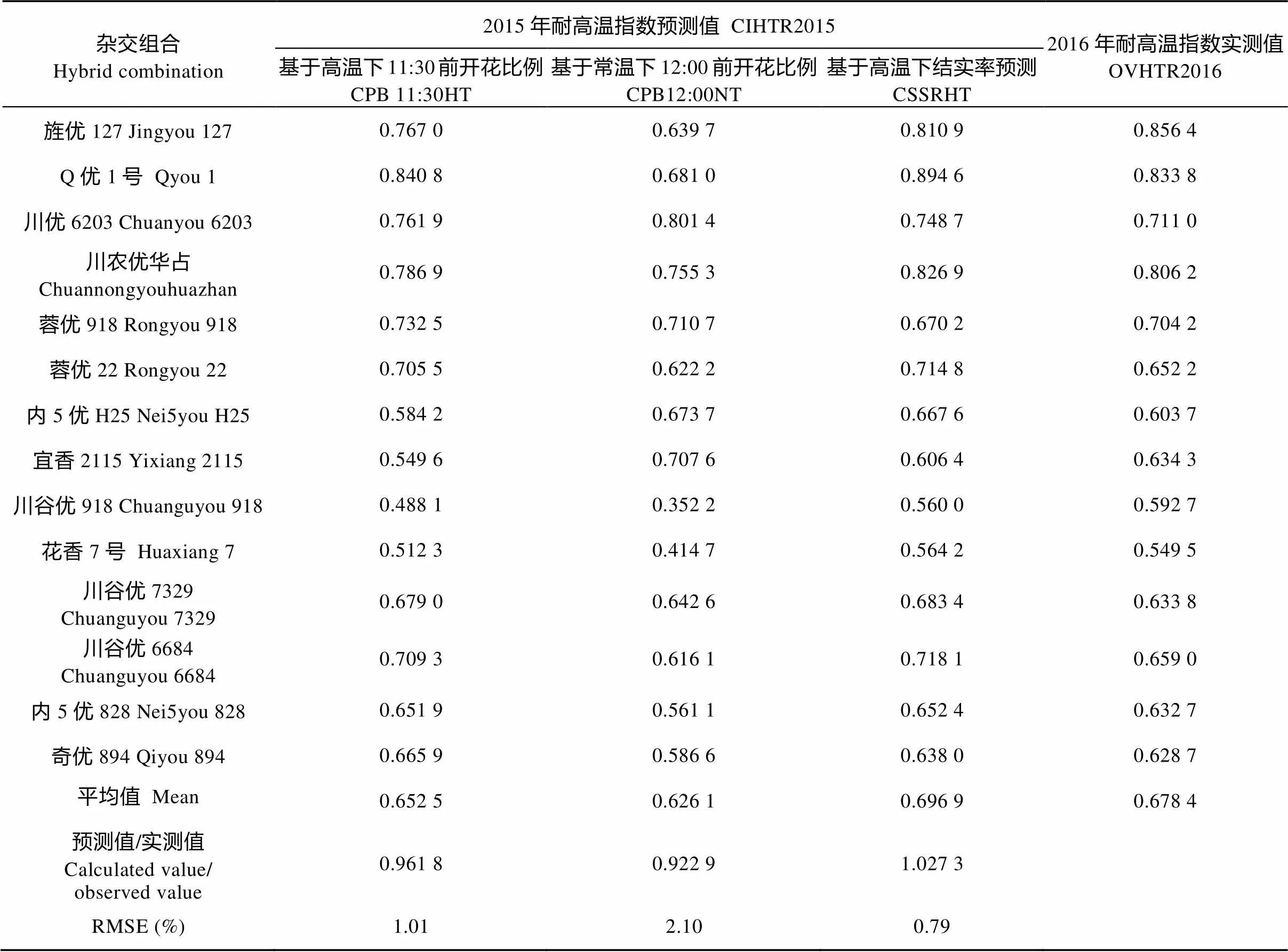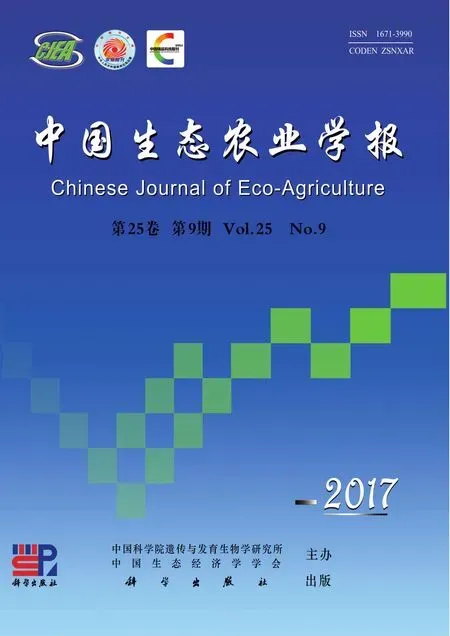利用杂交水稻开花比例鉴定耐高温性的方法*
徐富贤, 周兴兵, 蒋 鹏, 张 林, 熊 洪, 郭晓艺, 朱永川, 刘 茂
利用杂交水稻开花比例鉴定耐高温性的方法*
徐富贤, 周兴兵, 蒋 鹏, 张 林, 熊 洪, 郭晓艺, 朱永川, 刘 茂
(四川省农业科学院水稻高粱研究所/农业部西南水稻生物学与遗传育种重点实验室 德阳 618000)
选用水稻开花期耐高温能力强的品种, 是缓解极端自然高温导致大幅减产的有效途径之一。为改进水稻品种耐高温性的鉴定技术, 2013年和2014年以4个杂交水稻品种为材料, 用钵栽方法, 分别在开花前后不同时间将钵栽水稻移至人工气候室38.0 ℃高温下处理5 h, 以室外常温(穗层日最高气温31.2~32.8 ℃)处理为对照, 研究极端高温时段对结实率的影响。2015年和2016年以40个杂交中稻组合为材料进行5个分期播种试验, 于水稻穗层温度达35 ℃以上时期, 从5个播种期中选择20个同期开始抽穗、生长整齐的稻穗挂牌标记, 观察不同时段开花比例, 以研究品种间开花期耐高温能力与不同时间开花比例关系。结果表明, 杂交水稻开花期高温下11:30前的开花比例、常温下12:00前开花比例分别与耐高温指数呈极显著正相关关系, 耐高温品种主要通过提高高温下的结实率而间接增强其耐高温指数, 而高温下的结实率则直接影响耐高温指数。高温下开花早的品种在常温下开花也早, 杂交水稻开花时间主要集中在9:30—12:30, 品种间在不同时刻开花的比例各异。开花后2 h遇高温对结实率影响不明显; 穗层气温34 ℃、35 ℃且频率达80%以上的最早出现时间分别在13:30和15:30, 选择日最高温度≥34 ℃或35 ℃出现前2 h开花比例高的品种, 能有效地避开高温伤害。基于以上分析分别建立了利用开花期高温下11:30前开花比例、常温下12:00前开花比例和高温下结实率3个指标预测鉴定耐高温指数回归模型, 准确率(预测值/实测值)高达92.29%~102.73%。为水稻品种开花期耐高温性鉴定提供了科学适用的新方法。
杂交水稻; 高温胁迫; 开花时刻; 开花比例; 结实率; 耐高温指数; 鉴定方法
如何解决水稻开花期的极端高温导致结实率大幅度降低而减产, 已成为一个全球性难题[1-2]。我国长江流域是高温危害重灾区, 尤其对杂交水稻影响更为严重, 已引起国家有关部门的高度重视。为此国内外就水稻品种开花期耐高温机理及缓解高温胁迫技术进行了广泛研究[1-17], 并将耐高温品种选择作为抵御高温危害的重要措施[7-12]。但耐高温品种的鉴定方法是一个薄弱环节[1], 目前常用的人工气候室法或自然高温鉴定法, 因受条件所限难以普遍应用; 虽然较多学者通过研究高温胁迫下水稻品种间可溶性糖、可溶性蛋白、游离脯氨酸、热稳定蛋白、膜透性、MDA含量、关键酶Rubisco、活化酶RuBP、花粉的活力、萌发率等生理生化指标的响应[6,10-11,13-17], 为破解水稻品种间耐高温差异的机理方面有一定进展, 但要将其研究成果应用于耐高温品种的鉴定上尚有较大差距。因此作者在先期已明确花时早而集中的杂交组合开花期耐高温能力强[7]的基础上, 试图进一步探索杂交水稻品种间不同时点开花比例与耐高温性的定量关系, 以期为水稻开花期耐高温品种的鉴定提供一种简便、适用的科学方法。
1 材料与方法
试验在四川省农业科学院水稻高粱研究所泸县实验基地的冬水田及智能人工气候室进行, 田间试验土壤质地均匀, 中上等肥力。试验点所在地泸县为典型的高温伏旱区, 常年≥10 ℃有效积温5 500 ℃, 年均气温18~18.6 ℃, 大面积杂交中稻抽穗到成熟期间平均日最高气温31.9~32.6 ℃, 平均日最低气温22.5~23.6 ℃, 其中开花期常遇35 ℃以上的高温伤害。
1.1 高温日穗层气温动态变化与极端高温时段对结实率影响试验
试验在温度精确度±0.5 ℃的智能人工气候室(北京易盛泰和科技有限公司制)进行。采用钵栽试验, 取稻田干土(pH 6.62, 有机质22.34 g×kg-1, 全氮1.58 g×kg-1, 全磷0.74 g×kg-1, 全钾11.54 g×kg-1, 有效氮147.6 mg×kg-1, 有效磷85.4 mg×kg-1, 有效钾163.1 mg×kg-1), 经晒场整细混均后将4 kg土装入塑料钵内(钵为长方体, 高33 cm、长30 cm、宽20 cm)。2013年、2014年以4个杂交中稻组合为供试材料, 分别为‘Q优1号’、‘川谷优7329’、‘蓉优908’和‘花香7号’。
3月7日播种, 地膜培育中苗秧, 4.5叶移栽至钵盆。氮按每钵1.5 g施用, 其中底肥50%、蘖肥20%、穗肥30%, 磷、钾肥按N∶P2O5∶K2O=1∶0.5∶1.0比例作底肥一次性施入。各品种栽13~15钵, 每钵栽3穴, 每穴栽双株。抽穗期于高温处理前1天17:00时, 选择次日将开花的稻穗一段, 将两头挂吊牌标记(剪去已开颖花), 分别于次日开花前5 h(6:00)、开花当时(11:00左右, 据多年观察多数品种集中11:00时前后大量开花)、开花后1 h(12:00)、开花后1.5 h(12:30)、开花后2 h(13:00)进行高温处理。高温处理前10 min, 将前日两头挂吊牌段以内未开的少数颖花剪掉, 标记1 320~1 680朵颖花, 6次重复。将其中3个重复的盆钵移至人工气候室高温处理5 h (相对湿度85%, 温度为38.0 ℃), 另3个重复放在室外常温下(穗层日最高气温31.2~32.8 ℃), 高温处理期间保持盆钵内浅水层。高温处理结束后将盆钵移至室外管理。于成熟期分别收获, 考查各处理两头挂吊牌段以内籽粒的结实率和耐高温指数(耐高温指数=高温处理下结实率/常温处理下结实率, 后同)。
2013年、2014年、2015年、2016年, 在泸县实验基地本试验田, 于水稻抽穗期间, 用竹杆将水银温度计吊挂于田间穗层高度, 观测日最高气温, 当出现有35 ℃以上高温日时, 再结合天气预报, 若以后几天将是晴天, 则把第2 d作为高温稳定期。分别于35 ℃以上高温日稳定期, 连续观测7:30至15:30时的穗层温度(取全田3个观测点平均值), 每小时记录1次。
1.2 自然高温对结实率影响与品种间开花习性关系试验
2013—2016年试验自然高温处理从分期播种中选择水稻开花期穗层日最高气温为35~37.7 ℃。
2015年、2016年均以通过审定的40个杂交中稻组合为材料进行分期播种试验。两年均分别于3月5日、3月25日、4月20日、5月4日、5月24日播种(目的为终有一个播期的杂交组合在抽穗期能遇自然高温), 地膜湿润育秧, 4.5叶移栽, 大田按30 cm×20 cm规格每穴栽双株, 本田施氮150 kg×hm-2(底肥∶蘖肥∶穗肥= 5∶3∶2), 磷、钾肥按N∶P2O5∶K2O=1∶0.5∶0.8作底肥一次施用。每期各杂交组合移栽120穴, 重复3次, 裂区设计; 以播期为主区, 杂交组合为副区。
2015年、2016年分别观察到对水稻开花受精具有明显伤害的高温(日最高温度达35 ℃)[2]稳定期在7月15日和7月28日。此高温期间由于在5个播种期中, 只有2015年3月25日播种、2016年4月20日播种的绝大多数杂交组合正处于抽穗期。因此, 分别选从2015年3月25日和2016年4月20日播种的40个杂交组合中选择20个同期抽穗、生长整齐的稻穗挂牌标记, 每个杂交组合每次重复挂牌标记6~8穗, 重复3次。虽然两年的40个试验品种完全相同, 但各品种年度间生育期表现不完全一致, 两年试验选择同时遇高温的20个组合中只有14个组合相同。于高温期间, 连续4 d分别统计11:00以前、11:00—11:30、11:30—12:00的开花数(以剪颖花一微小角作为已开花记号)。成熟期将3月5日播种(常温下抽穗)与高温日挂牌标记相同的20个组合, 各取样5穴, 3次重复, 从高温日播种期中选定的20个组合挂牌标记定穗的穗子全部取样, 考查穗部性状, 并计算各杂交组合抽穗期的耐高温指数。
以上试验数据的方差、相关及回归分析由DPS数据处理系统和Microsoft Excel操作系统完成。
2 结果与分析
2.1 杂交水稻品种间开花动态与耐高温性的关系
从试验结果(表1)可见, 不同杂交水稻品种之间在常温和高温下开花的结实率及耐高温指数均达显著或极显著差异(方差分析值为4.23*~-10.54**), 耐高温指数与高温下结实率呈极显著正相关(值为0.960 5**~0.984 1**); 耐高温指数达0.8以上的品种有‘旌优127’、‘Q优1号’、‘川农优华占’。
无论高温还是常温下杂交品种间各时段开花比例均达显著或极显著差异(=3.56*~6.01**), 高温下11:30前和12:00前、常温下12:00前开花比例, 分别与耐高温指数呈显著或极显著正相关(值为0.487 6**~0.732 2**)(表2)。表1、表2数据的回归分析结果表明, 高温下11:30前开花比例(2)和常温下12:00前开花比例(6)对耐高温指数有极显著影响(表3)。以上两年结果趋势一致。
2.2 杂交水稻品种间开花动态影响耐高温性的原因
试验结果(表4)表明, 开花前5 h高温对结实没有显著影响, 受高温伤害的敏感期在开花当时, 对受精影响最大, 造成结实率显著下降。开花后不同时间的高温对结实率的影响品种间表现各异。参试4个品种中, 开花后1 h的高温处理下仅‘Q优1号’结实未受显著影响, 开花后1.5 h的高温处理下有‘Q优1号’和‘川谷优7329’2个品种结实未受影响, 而开花后2 h的高温处理下4个品种结实均未受影响。2013—2016年水稻开花期共16个35 ℃高温日各时点穗层温度和发生频率如图1、图2所示。从图1可见, 从7:30—15:30时, 气温呈上升趋势, 而且气温分别高于33 ℃、34 ℃和35 ℃的频率达80%以上, 最早出现的时间分别在11:30、13:30和15:30(图2)。而杂交水稻开花时间主要在9:30—12:30, 不同水稻品种间在不同时刻开花的比例各不相同。目前较为一致研究认为, 日均温30 ℃或日最高温度≥35 ℃是水稻开花期受高温伤害的临界温度[1-2]。因此, 在选择日最高温度≥34 ℃或35 ℃出现前2 h开花比例高的品种, 能有效地避开高温伤害。

表1 杂交水稻品种在不同温度下开花的结实率与耐高温指数表现
SSRNT: seed setting rate at normal temperature; SSRHT: seed setting rate at high temperature; HTRI: high temperature resistance index
由于高温下开花早的品种在常温下开花也早(图3), 因此高温下11:30前和常温下12:00前开花比例高的品种, 其耐高温指数较高。
2.3 利用开花比例预测杂交水稻耐高温性的准确率分析
为了建立水稻品种耐高温性的间接鉴定方法, 以2015年、2016两年试验数据平均值, 进行对品种间耐高温指数有较大影响的高温下11:30前开花比例、常温下12:00前开花比例和高温下结实率3因素与耐高温指数的回归分析, 回归方程决定系数达71.46%~95.49%, 相关系数达极显著水平(值为0.845 3**~0.977 2**)。利用试验测定值与预测值之间的均方差根(RMSE)对模型进行检验[18], RMSE为0.41%~1.12%, 测定数据与预测值之间表现较好一致性(表5)。因此可用这些回归方程作为评价耐高温指数的间接指标。

表2 杂交水稻品种高温和常温下各时段开花比例
PBNT: proportion of blossom at normal temperature; PBHT: proportion of blossom at high temperature; HTRI: high temperature resistance index.

表3 耐高温指数(Y)与高温和常温下杂交水稻品种各时段开花比例(X)的多元回归分析

表4 不同开花时段高温处理对杂交水稻结实率的影响
同行数据后不同字母表示各高温处理时段差异显著(<0.05)。Values within the same line followed by different letters are significantly different at 0.05 probability level.
图2 4年试验期间16个高温日各时点高温出现频率
Fig. 2 Frequency of high temperature at different times for 16 days with high temperature in 4 years of the experiment
为了进一步验证以上回归方程应用的可靠性, 特以两年在高温处理下相同的14个品种的2015年实测的高温下11:30前开花比例、常温下12:00前开花比例、高温下结实率数据, 分别预测其耐高温指数, 再分别将其预测值与2016年该14个品种实测的耐高温指数之间进行均方差根(RMSE)检验, RMSE为0.79%~2.10%, 准确率(预测值/实测值)高达92.29%~102.73%(表6)。
从水稻开花期耐高温指数()与高温下11:30前开花比例(1)、常温下12:00开花比例(2)和高温下结实率(3)的多元回归分析结果(表7)可见, 仅有高温下结实率(3)的偏相关系数达极显著水平, 而高温下11:30前开花比例(1)、常温下12:00前开花比例(2)的偏相关系数则不显著。究其原因, 虽然高温下11:30前开花比例(1)、常温下12:00前开花比例(2)分别与耐高温指数()相关极显著, 但主要通过高温下结实率(3)间接影响耐高温指数(), 其直接作用甚微; 而高温下结实率(3)对耐高温指数()直接作用极大(表8)。

表5 耐高温指数(y)与不同温度下开花比例及高温下结实率(x)的回归分析(两年平均)
PB11:30HT: proportion of blossom before 11:30 during high temperature stage; PB12:00NT: proportion of blossom before 12:00 during normal temperature stage; SSRHT: seed setting rate at high temperature.

表6 2015年耐高温指数预测值与2016年相同品种实测值的比较
CIHTR2015: calculated value of high temperature resistance index in 2015; OVHTR2016: observed values of high temperature resistance index in 2016; CPB11:30HT: calculating with the proportion of blossom before 11:30 during high temperature stage; CPB12:00NT: calculating with the proportion of blossom before 12:00 during normal temperature stage; CSSRHT: calculating with seed setting rate at high temperature.

表7 水稻开花期耐高温指数(y)与不同温度下开花比例及高温下结实率(x)的多元回归分析
1: 高温下11:30前开花比例;2: 常温下12:00前开花比例;3: 高温下结实率。1: proportion of blossom before 11:30 during high temperature stage;2: proportion of blossom before 12:00 during normal temperature stage;3: seed setting rate at high temperature.

表8 不同温度下水稻开花比例及高温下结实率(x)对耐高温指数(y)的通径分析
*2=0.947 9,=40.1: 高温下11:30前开花比例;2: 常温下12:00前开花比例;3: 高温下结实率.1: proportion of blossom before 11:30 during high temperature stage;2: proportion of blossom before 12:00 during normal temperature stage;3: seed setting rate at high temperature.
3 讨论
3.1 关于开花期不同时点高温对结实率的影响
本研究表明, 开花前5 h的高温对结实率影响不显著、开花当时高温处理结实率显著降低, 与前人研究结论基本一致[2,19-20]。Satake等[19]发现, 高温对已经开过的颖花和高温处理1 h后开放的颖花几乎不产生影响。朱兴明等[20]研究则认为, 花后1 h的自然高温对结实率无明显影响; 而谭中和等[2]在人工气候箱控温条件下的研究结果指出, 在开花后4 h的高温对受精仍有较大影响。本研究则指出, 花后不同时间的高温对结实率的影响因品种而异, 参试4个品种中, 于花后1 h、1.5 h和2 h分别进行高温处理5 h(相对湿度85%, 温度为38.0 ℃)条件下, 分别有3个、2个和0个品种对结实率有显著影响, 较为一致的是开花后2 h的高温处理对结实无明显影响。与前人研究结论有一定差异, 可能与试验采用品种和温度、湿度条件不同有关。
根据本研究结果, 杂交水稻开花时间主要在9:30—12:30, 不同品种间在不同时刻开花的比例各不相同, 气温越高花时越早, 杂交水稻在自然高温下因花时早于日最高温发生前, 受高温伤害较小。穗层气温高于34 ℃以上频率超过80%的最早出现的时间在13:30时。日均温30 ℃或最高温度≥35 ℃是水稻开花期受高温伤害的临界温度, 但品种间存在一定差异[1-2]。因此, 为了提高开花期结实不受高温影响的安全保证率, 选择日最高温度≥34 ℃出现前2 h即11:30前开花比例高的品种, 能有效地避开高温伤害。
3.2 关于水稻开花期耐高温杂交品种的鉴定指标
影响水稻开花期与耐高温性有关的生理生化指标较多。花药内酸性蔗糖酶活性低, 花粉粒内单糖含量少的品种耐高温能力差[1]。剑叶的光合特性及叶绿素含量、可溶性糖、可溶性蛋白、游离脯氨酸和热稳定蛋白含量高, 膜透性和MDA含量低的品种耐高温能力强[13]。高温胁迫下光合作用的关键酶活性、光合速率高[6,14]、花粉活力、花粉萌发率高[15-16,21]、柱头上授粉数多[22]的品种耐高温能力强。利用这些研究结论指导研发缓解开花期高温对结实率伤害的物化产品具有重要作用, 但利用这些生理生化指标在高温胁迫下鉴定耐高温品种则需要通过实验室测试分析, 不仅存在时效性上滞后, 而且其准确性也不会很高。
结实率是对高温反应最好的直接指标, 而且方便可靠感观度极强。目前多采用耐高温指数=高温下结实率/常温下结实率×100%作为品种间耐高温性的筛选指标[1,4,7], 但获得耐高温指数的两个措施即人工气候箱(室)鉴定法和自然高温鉴定法均有一定局限性。人工气候箱(室)鉴定将鉴定品种通过盆栽, 于水稻开花期将每个品种分为两部分, 一部分放在人工气候箱(室)进行高温处理, 另一部分在室外常温下开花, 成熟期分别考查结实率以计算耐高温指数。主要问题: 一是需要人工气候箱(室), 较多单位没有此条件; 二是在室外常温下开花处理常遇自然高温, 以致鉴定工作失败。自然高温鉴定法将拟鉴定品种分为3~5期播种, 期望其中有一期开花期遇到高温, 另有一期在常温下开花, 成熟期分别考查结实率并计算耐高温指数。主要问题: 一是只能在有高温发生的地区鉴定, 受地域限制; 二是既使在高温地区, 有的年份没有高温出现或所播的期数较少而开花期错开了高温发生期, 最终鉴定工作失败; 三是需要播种3~5期的工作量较大。因此有必要开展更高效、适用的耐高温品种的鉴定方法。
3.3 利用开花比例鉴定耐高温特性的优势与应用方法
与现有水稻品种耐高温特性的鉴定方法相比, 利用开花比例的鉴定方法的优势在于, 开花期在高温或常温下均可鉴定, 只需种植一期, 不仅鉴定成本比传统分期播种法低, 还可鉴定大批量品种。因为水稻每日开花时刻的早迟与当日气温有关, 温度越高开花时间越早, 即在常温下开花早的品种, 在高温下开花更早。所以, 本方法不但不存在不能遇自然高温而造成鉴定工作失败的问题, 而且非高温地区也能鉴定。具体鉴定方法如下:
首先将拟鉴定的杂交水稻品种按播种—抽穗期相差3 d以内的分为一类, 每类品种按当地常规高产栽培技术种植, 每个品种栽3~5行, 每行栽10穴。然后选择同期开始抽穗、生长整齐的稻穗挂牌标记, 每个品种每次重复挂牌标记6~8穗, 重复3次, 并连续4 d天分别统计各品种上午11:30(遇高温)或12:00(未遇高温)以前的开花数。最后将每个品种挂牌标记的稻穗取回室内考查平均每穗的颖花数, 并分别统计各品种上午11:30时或12:00时以前的开花数占每穗的颖花数的比例, 再通过对开花比例的方差分析结果以确定品种间耐高温性的差异。
4 结论
杂交水稻花期高温下11:30前的开花比例、常温下12:00前开花比例分别与耐高温指数呈极显著正相关。开花后2 h的遇高温对结实率影响不明显, 穗层气温34 ℃、35 ℃以上且频率达80%以上的最早出现时间分别在13:30和15:30, 分别建立了利用开花期高温下11:30前开花比例、常温下12:00前开花比例和高温下结实率3个指标预测鉴定耐高温指数回归模型。
[1] 田小海, 松井勤, 李守华, 等. 水稻花期高温胁迫研究进展与展望[J]. 应用生态学报, 2007, 18(11): 2632–2636 Tian X H, Mastsui T, Li S H, et al. High temperature stress on rice anthesis: Research progress and prospects[J]. Chinese Journal of Applied Ecology, 2007, 18(11): 2632–2636
[2] 谭中和, 蓝泰源, 任昌福, 等. 杂交籼稻开花期高温危害及其对策的研究[J]. 作物学报, 1985, 11(2): 103–108 Tan Z H, Lan T Y, Ren C F, et al. Studies on high temperature injury on hybrid rice at flowering time and the strategy to avoid high temperature damage[J]. Acta Agronomica Sinica, 1985, 11(2): 103–108
[3] 李飞, 卓壮, Udawela U A K S, 等. 水稻高温热害发生机理与耐高温遗传基础研究[J]. 植物遗传资源学报, 2013, 14(1): 97–103 Li F, Zhuo Z, Udawela U A K S, et al. Damage mechanism of heat stress and genetic basis of heat tolerance in rice[J]. Journal of Plant Genetic Resources, 2013, 14(1): 97–103
[4] 王志刚, 王磊, 林海, 等. 水稻高温热害及耐热性研究进展[J]. 中国稻米, 2013, 19(1): 27–31 Wang Z G, Wang L, Lin H, et al. Research progress on rice heat damage and heat resistance of high temperature[J]. China Rice, 2013, 19(1): 27–31
[5] 高伟, 徐延浩, 吴晨阳, 等. 水稻生殖生长期的高温危害与表观遗传[J]. 长江大学学报: 自然科学版, 2013, 10(11): 1–5 Gao W, Xu Y H, Wu C Y, et al. High temperature harm and epigenetic at rice reproductive growth stage[J]. Journal of Yangtze University: Natural Science Edition, 2013, 10(11): 1–5
[6] 任昌福, 陈安和, 刘保国. 高温影响杂交水稻开花结实的生理生化基础[J]. 西南农业大学学报, 1990, 12(5): 440–443 Ren C F, Chen A H, Liu B G. The effect of high temperature on the physiology and biochemical foundation of flowering and fertilization of hybrid rice[J]. Journal of Southwest Agricultural University, 1990, 12(5): 440–443
[7] 徐富贤, 张林, 熊洪, 等. 杂交中稻开花期高温对结实率影响及其与组合间库源结构和开花习性的关系[J]. 作物学报, 2015, 41(6): 946–955 Xu F X, Zhang L, Xiong H, et al. Effects of high temperature during flowering period on seed setting rate and its relationship with sink to source ratios and flowering habit of mid-season hybrid rice[J]. Acta Agronomica Sinica, 2015, 41(6): 946–955
[8] 盛婧, 陈留根, 朱普平, 等. 不同水稻品种抽穗期对高温的响应及避热的调控措施[J]. 江苏农业学报, 2006, 22(4): 325–330 Sheng J, Chen L G, Zhu P P, et al. Responses of rice varieties to high temperature at heading stage and methods for heat escape[J]. Jiangsu Journal of Agricultural Sciences, 2006, 22(4): 325–330
[9] 石春林, 金之庆, 汤日圣, 等. 水稻颖花结实率对减数分裂期和开花期高温的响应差异[J]. 江苏农业学报, 2010, 26(6): 1139–1142 Shi C L, Jin Z Q, Tang R S, et al. Response difference of seed setting rate of rice florets at the meiosis and anthesis stages to high temperature[J]. Jiangsu Journal of Agricultural Sciences, 2006, 26(6): 1139–1142
[10] 黄英金, 罗永锋, 黄兴作, 等. 水稻灌浆期耐热性的品种间差异及其与剑叶光合特性和内源多胺的关系[J]. 中国水稻科学, 1999, 13(4): 205–210 Huang Y J, Luo Y F, Huang X Z, et al. Varietal difference of heat tolerance at grain filling stage and its relationship to photosynthetic characteristics and endogenous polyamine of flag leaf in rice[J]. Chinese Journal of Rice Science, 1999, 13(4): 205–210
[11] 朱雪梅, 柯永培, 邵继荣, 等. 高温胁迫对重穗型水稻品种叶片活性氧代谢的影响[J]. 种子, 2005, 24(3): 25–27 Zhu X M, Ke Y P, Shao J R, et al. Effects of high temperature stress on activated oxygen metabolism of the leaves of the heavy panicle type of medium India hybrid rice[J]. Seed, 2005, 24(3): 25–27
[12] 曹云英, 段骅, 杨立年, 等. 抽穗和灌浆早期高温对耐热性不同籼稻品种产量的影响及其生理原因[J]. 作物学报, 2009, 35(3): 512–521Cao Y Y, Duan H, Yang L N, et al. Effect of high temperature during heading and early grain filling on grain yield of indica rice cultivars differing in heat-tolerance and its physiological mechanism[J]. Acta Agronomica Sinica, 2009, 35(3): 512–521
[13] 张桂莲, 陈立云, 张顺堂, 等. 抽穗开花期高温对水稻剑叶理化特性的影响[J]. 中国农业科学, 2007, 40(7): 1345–1352 Zhang G L, Chen L Y, Zhang S T, et al. Effects of high temperature on the physiological and biochemical characteristics in flag leaves of rice at heading and flowering period[J]. Scientia Agricultura Sinica, 2007, 40(7): 1345–1352
教师作为学校教育的主导力量,对学生的成长有着重要的影响。调查结果表明,教师有些行为不合适,也容易引起学生课堂问题行为(见表2)。
[14] 雷东阳, 陈立云, 李稳香, 等. 高温对不同杂交稻开花期影响的生理差异[J]. 农业现代化研究, 2005, 26(5): 397–400 Lei D Y, Chen L Y, Li W X, et al. Effect of high temperature on physiology difference of flowering among different hybrid rice[J]. Research of Agricultural Modernization, 2005, 26(5): 397–400
[15] 汤日圣, 郑建初, 张大栋, 等. 高温对不同水稻品种花粉活力及籽粒结实的影响[J]. 江苏农业学报, 2006, 22(4): 369–373 Tang R S, Zheng J C, Zhang D D, et al. Effects of high temperatures on pollen vitality and seed setting of different rice varieties[J]. Jiangsu Journal of Agricultural Sciences, 2006, 22(4): 369–373
[16] 郭晶心, 曾文智, 周宝津, 等. 开花期高温胁迫对不同水稻品种花粉萌发和结实的影响[J]. 华南农业大学学报, 2010, 31(2): 50–53Guo J X, Zeng W Z, Zhou B J, et al. Effect of high temperature on pollen germination and seed setting of rice during heading period[J]. Journal of South China Agricultural University, 2010, 31(2): 50–53
[17] 李天, 刘奇华, 大杉立, 等. 灌浆结实期高温对水稻籽粒蔗糖及降解酶活性的影响[J]. 中国水稻科学, 2006, 20(6): 626–630 Li T, Liu Q H, Ohsugi R, et al. Effect of high temperature on sucrose content and sucrose-cleaving enzymes activity in rice during grain filling stage[J]. Chinese Journal of Rice Science,2006, 20(6): 626–630
[19] Satake T, Yoshida S. High temperature-induced sterility in indica rices at flowering[J]. Japan Journal of Crop Science, 1978, 47(1): 6–17
[20] 朱兴明, 曾庆曦, 宁清利. 自然高温对杂交稻开花受精的影响[J]. 中国农业科学, 1983, 16(2): 37–44 Zhu X M, Zeng Q X, Ning Q L. Effect of natural high temperature on flowering and fertilization in hybrid rice[J]. Scientia Agricultura Sinica, 1983, 16(2): 37–44
[21] 段骅, 唐琪, 剧成欣, 等. 抽穗灌浆早期高温与干旱对不同水稻品种产量和品质的影响[J]. 中国农业科学, 2012, 45(22): 4561–4573 Duan H, Tang Q, Ju C X, et al. Effect of high temperature and drought on grain yield and quality of different rice varieties during heading and early grain filling periods[J]. Scientia Agricultura Sinica, 2012, 45(22): 4561–4573
[22] Yoshida S, Satake T, Mackill D S. High-temperature stress in rice[J]. IRRI Research Paper Series, 1981, (67): 15
Identification method of high temperature resistance of hybrid rice based on flowering rate*
XU Fuxian, ZHOU Xingbing, JIANG Peng, ZHANG Lin, XIONG Hong, GUO Xiaoyi, ZHU Yongchuan, LIU Mao
(Institute of Rice and Sorghum Research, Sichuan Academy of Agricultural Sciences / Key Laboratory of Southwest Rice Biology and Genetic Breeding, Ministry of Agriculture, Deyang 618000, China)
Using cultivars with high temperature resistance is an effectively approach to reduce yield loss induced by extreme high temperature. The objective of this study was to improve the identification method for high temperature resistance of hybrid rice varieties in both pot and field experiments. To that end, a pot experiment was conducted in an intelligent artificial climate chamber to determine the effects of extreme high temperature (38 ℃) on percentage grain filling at grain-filling stage in 2013 and 2014. Four cultivars were planted and exposed to extreme high temperature for 5 hours at 5.0 hours before and during flowering stage, and 1.0 hour, 1.5 hours and 2 hours after flowering stage. Also concurrently, hybrid rice cultivars were grown under normal background conditions (daily maximum temperature of panicle layer of approximately 31.2-32.8 ℃) as control (CK). A field experiment was conducted using 40 hybrid rice cultivars to study the relationship between high temperature resistance and flowering rate of hybrid rice at different times of the days based on 5 sowing dates (March 5, March 25, April 20, May 4 and May 24) in 2015-2016. In each year, 20 cultivars with same heading date were selected from 5 sowing dates to observe flowering rate at different times of the day. The results showed a significantly positive linear correlation between high temperature resistance index and flowering rate of hybrid rice before 11:30 AM under high temperature condition or before 12:00 noon under normal temperature condition. The increase in seed setting rate of high temperature resistant variety under high temperature condition was indirectly related with high temperature resistance index, while its’ seed setting rate under high temperature condition was directly related with high temperature resistance index. Flowering of hybrid rice occurred earlier under high temperature condition, the cultivar flowering was also earlier under normal temperature condition. Flowering of hybrid rice was mainly concentrated around 9:30 AM to 12:30 PM. However, flowering rate differed with cultivar at different times of the day. Seed setting rate was not significantly affected by high temperature after 2 hours of flowering. When panicle layer temperature was 34 ℃ and 35 ℃, and their frequency reached 80% at 13:30 PM and at 15:30 PM, respectively, choosing cultivars that flowered 2 hours before high temperature (daily maximum temperature greater than 34 ℃ or at about 35 ℃) could effectively resist high temperature injury. Regression equation was established based on flowering rate before 11:30 AM under high temperature and before 12:00 noon under normal temperature condition and seed setting rate under high temperature condition. The equation provided a new identification method of high temperature resistance of hybrid rice cultivars at flowering stage at a percent accuracy (estimated value / measured value) of up to 92.29%-102.73%.
Hybrid rice; High temperature stress; Flowering time; Flowering ratio; Seed setting rate; High temperature resistance index; Identification method
XU Fuxian, E-mail: xu6501@163.com
Feb. 24, 2017; accepted May 18, 2017
S511.037
A
1671-3990(2017)09-1335-10
10.13930/j.cnki.cjea.170156
2017-02-24
2017-05-18
* This study was supported by the China Agriculture Research System (CARS-01-29), the Special Fund for Agro-scientific Research in the Public Interest of China (20120302), the National Grain Bumper Science and Technology Project of China (2013BAD07B13-05), and the Sichuan Financial Genetic Engineering Project.
* 国家现代农业产业技术体系建设专项(CARS-01-29)、国家公益性行业(农业)专项(20120302)、国家粮食丰产科技工程(2013BAD07B13-05)和四川省财政基因工程项目资助
徐富贤, 主要从事水稻生理、生态与高产高效技术研究。E-mail: xu6501@163.com
徐富贤, 周兴兵, 蒋鹏, 张林, 熊洪, 郭晓艺, 朱永川, 刘茂. 利用杂交水稻开花比例鉴定耐高温性的方法[J]. 中国生态农业学报, 2017, 25(9): 1335-1344
Xu F X, Zhou X B, Jiang P, Zhang L, Xiong H, Guo X Y, Zhu Y C, Liu M. Identification method of high temperature resistance of hybrid rice based on flowering rate[J]. Chinese Journal of Eco-Agriculture, 2017, 25(9): 1335-1344

